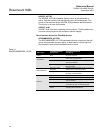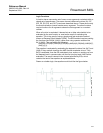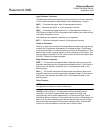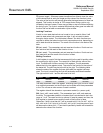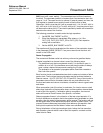
Reference Manual
00809-0100-4696, Rev AA
September 2004
Rosemount 848L
3-12
The following characters are allowed in a logic equation:
• Uppercase and lowercase alphabet, case insensitive, used to specify
functions
• Digits 0-9, used to specify channel numbers and unsigned integer
constants
• Comma, used to separate parameters in a function parameter list
• Parentheses() used to define the extent of the parameter list of a
function
• Semicolon; used to terminate an equation
• Space (not tab), ignored by parser, may be used to make an equation
more readable but counts as a character
The following characters are specifically not allowed in a logic:
• The period (dot) character is not allowed. There are no decimal
numbers.
• The unary minus (-) character is not allowed. There are no negative
integers.
• The math operators (+, -, *, /, **) are not allowed, nor are symbols for
any logic operators (&, |, <, >, ...).
Functions must be from the list of Logic Functions below, and must have the
specified number of parameters.
Channel Functions
The following functions read channel value and status. The number of
instances of these functions is unlimited, except for PS. A channel value and
status is set by the I/O processor at the beginning of an equation evaluation
cycle, by the equations as they complete evaluation, or by macrocycle
evaluations of any DO blocks attached to channels 9 through 16. The status
of channels 9-16 is always good, even if the DO block has a bad status.
IN - The input hardware sets the values of channels 1-8. Configured DI blocks
may specify these channels in order to read the specified hardware input. The
value of an input may be referenced in an equation by the IN (i) function,
where the channel number is placed between the parentheses. The range of
‘i’ is 1 to 8. Multiple references to any channel are allowed.
ICR, ICF - I/O samples are taken every millisecond, which is considerably
faster than equation executions. It is possible for an input to turn on and turn
off during an equation evaluation cycle, so that it would not be seen by an
IN (i) function. Each input has a counter for transitions (rise or fall). A
transition is based on the output of the debounce filter, not the raw input.
Filtering can be set to zero. The counter is read and cleared at the beginning
of each evaluation cycle. The method relies completely on the counter and
does not use the latch configuration. The ICR (i) function is true for one
evaluation cycle if a rising transition occurred, and its opposite ICF (i) is true
for a falling transition.







